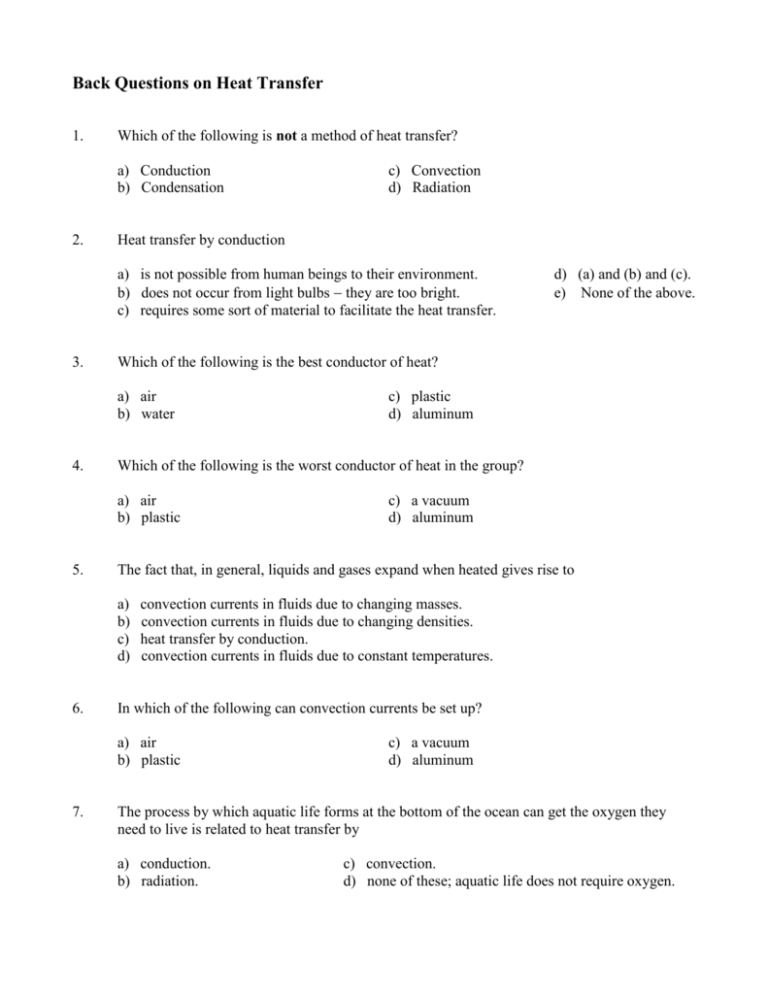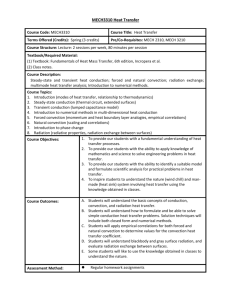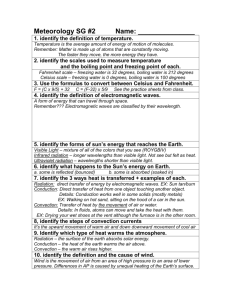Back Questions on Conduction, Convection, and Radiation
advertisement

Back Questions on Heat Transfer 1. Which of the following is not a method of heat transfer? a) Conduction b) Condensation 2. c) Convection d) Radiation Heat transfer by conduction a) is not possible from human beings to their environment. b) does not occur from light bulbs they are too bright. c) requires some sort of material to facilitate the heat transfer. 3. Which of the following is the best conductor of heat? a) air b) water 4. convection currents in fluids due to changing masses. convection currents in fluids due to changing densities. heat transfer by conduction. convection currents in fluids due to constant temperatures. In which of the following can convection currents be set up? a) air b) plastic 7. c) a vacuum d) aluminum The fact that, in general, liquids and gases expand when heated gives rise to a) b) c) d) 6. c) plastic d) aluminum Which of the following is the worst conductor of heat in the group? a) air b) plastic 5. d) (a) and (b) and (c). e) None of the above. c) a vacuum d) aluminum The process by which aquatic life forms at the bottom of the ocean can get the oxygen they need to live is related to heat transfer by a) conduction. b) radiation. c) convection. d) none of these; aquatic life does not require oxygen. 8. Convection currents can be caused by a) weather patterns. b) unequal heating of the earth's surface. c) thermal expansion. 9. The predominant method of heat transfer that causes a pot of water to boil is a) conduction. b) radiation. 10. c) Convection. d) Blackbody. Heat transfer by radiation a) b) c) d) 14. c) convection. d) evaporation. This type of heat transfer can occur in a vacuum: a) Conduction. b) Radiation. 13. c) convection. d) evaporation. The method through which the entire pot of water boils on that hot stove is a) conduction. b) radiation. 12. c) convection. d) boiling. The process by which a pot of water on your electric stove starts to heat is a) conduction. b) radiation. 11. d) (b) and (c) but not (a). e) (a) and (b) and (c). is not possible from human beings to their environment. does not occur from light bulbs they are too bright. does not require any material between the radiator and the object receiving the radiation. none of the above. If a thermos bottle was not “silvered” on its surfaces, it would be able to transfer heat by a) conduction. b) convection. c) radiation. d) it would not be able to transfer heat at all. 15. The thermos bottle acts as a good thermal insulator because it can defeat a) convection. b) evaporation. 16. A thermos bottle that had the space between its inner chamber and outer covering filled with styrofoam instead of a vacuum would be most likely (or, most able) to transfer heat by a) conduction. b) convection. 17. c) radiation. d) It would not transfer heat. KYW radio station broadcasts at 1060 kHz. The _______of its EM waves is therefore _____ a) wavelength . . . 283 m. b) frequency . . . 283 s. 18. c) wavelength . . . 3.37 m. d) frequency . . . 3.37 s. Which color of visible light has the longest wavelength? a) Red b) Yellow 20. c) wavelength . . . 1,060,000 m. d) frequency . . . 1,060,000 s. WXVU radio station broadcasts at 89.1 MHz. The _______of its EM waves is therefore _____ a) wavelength . . . 3.7 106 m. b) frequency . . . 3.7 106 s. 19. c) condensation. d) all of these. c) Blue d) Violet Which color of visible light has the shortest wavelength? a) Red b) Yellow c) Blue d) Violet In questions 21 through 23, choose your answers from the following forms of electromagnetic radiation: a) X-Rays b) Microwaves c) Blue light d) FM Radio e) Infrared 21. Which of the above EM radiations has the highest energy? 22. Which of the above EM radiations has the longest wavelength? 23. Which of the above EM radiations are generated by the system with the smallest dimensions? In Questions 24 through 27, list the following electromagnetic radiations in order of increasing energy; that is, place the least energetic in answer space 24, and the most energetic in space 27, etc. a) Infrared 28. b) X-rays c) intensity. d) temperature. Which of the following stars should have the highest surface temperature? a) A red star like Antares. b) A yellow star like the sun. 33. d) (b) and (c) but not (a) e) (a) and (b) and (c) The peak frequency at which energy is radiated from a blackbody radiator is dependent on a) color. b) distance. 32. c) 3 10-1 Hz. d) 3 1017 Hz. Which type(s) of EM radiation have (a) wavelength(s) smaller than the X-rays in the previous question? a) Gamma rays b) Ultraviolet radiation c) Microwave radiation 31. c) Visible light. d) Xrays. X-Rays are emitted from atomic processes, and the radius of a typical x-ray radiating atom is 10-9 meters. What is the approximate frequency of the emitted EM radiation? a) 14 10-8 Hz. b) 14 1011 Hz. 30. d) AM radio Which of the following EM radiations are generated by the smallest objects? a) Microwaves. b) Gammarays. 29. c) Visible light c) A blue star like Rigel. d) They should all have the same surface temperature. An object much hotter than the sun (say, 10 times as hot) would probably radiate primarily (remember, best answer) a) in the infrared. b) in the visible range. c) in the ultraviolet. d) microwaves. 34. The frequency at which the EM radiation given off by a blackbody radiator is most intense is completely determined by the blackbody’s a) frequency. b) size. 35. Consider a star that radiates with a peak radiation frequency in the UV region of the EM spectrum. Which of the following statements is most likely true of the star? a) b) c) d) 36. The disappearance of the Bering land bridge. The creation of the Rift Valley in Eastern Africa. The advance of glaciers across the North American continent. The retreat of glaciers from the North American continent. The evidence in favor of the theory of plate tectonics does not include a) b) c) d) 39. mountains in America, Greenland, and Scandinavia. fossils in South America and Africa. Pangaea. (a) and (b) but not (c). (a) and (b) and (c). Which of the following is explained by the theory of plate tectonics? a) b) c) d) 38. Its temperature is approximately 4000 K. It would appear red-orange to us on earth. It would appear blue to us on earth. Its temperature is between 5000 and 7000 Kelvins. Evidence sited by Alfred Wegener to support his theory of continental drift could be found in a) b) c) d) e) 37. c) shape. d) temperature. fossil records in Africa and South America. the creation of the Himalaya mountains. the creation of the polar ice cap above the north geographic pole. sea floor spreading at the mid-Atlantic ridge. The underwater phenomenon of which the Mid-Atlantic ridge is a prototypical example is a) subduction. b) rift valley proto-creation. c) undersea tectonic collapse and construction. d) sea-floor spreading. 40. We see evidence of plate tectonics still at work in our world today in a) the African rift valley. b) fossils in South America and Africa. c) Hudson Bay, Canada. 41. d) (a) and (b) but not (c). e) (a) and (b) and (c). We see evidence of plate tectonics at work in our world today in a) the African rift valley. b) Atlantic seafloor spreading c) Hudson Bay, Canada. d) (a) and (b) but not (c). e) (a) and (b) and (c). Answer Key: 1. B 2. C 3. D 4. C 5. B 6. A 7. C 8. D 9. C 10. A 11. C 12. B 13. C 14. C 15. A 16. A 17. A 18. C 19. A 20. D 21. A 22. D 23. A 24. D 25. A 26. C 27. B 28. B 29. D 30. A 31. D 32. C 33. C 34. D 35. C 36. D 37. B 38. C 39. D 40. A 41. D
![Applied Heat Transfer [Opens in New Window]](http://s3.studylib.net/store/data/008526779_1-b12564ed87263f3384d65f395321d919-300x300.png)





